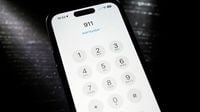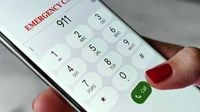On the afternoon of September 25, 2025, a sudden and widespread 911 outage swept across large portions of Louisiana and Mississippi, sending emergency officials scrambling and leaving many residents uncertain about how to get help in a crisis. The disruption, which lasted several hours, was traced to multiple fiber optic line cuts affecting AT&T's telecommunications network—a backbone for emergency communications in the region. While Alabama was initially reported as affected, officials later confirmed that its 911 services remained fully operational throughout the event, according to the Alabama 911 Board as reported by AL.com.
The trouble began shortly after 1 p.m. local time, when emergency management agencies in both Mississippi and Louisiana started receiving reports that 911 calls were not going through. The Mississippi Emergency Management Agency (MEMA) said it was notified by AT&T about a “series of fiber cuts” that were impacting their network, disrupting emergency call systems across the two states. Karl Fasold, Executive Director of the Orleans Parish Communication District, explained during a news conference (as cited by CNN and local outlets) that a “major fiber cut located in Mississippi…has taken out all of this.” He added, “There's no indication it was malicious.”
As the outage spread, it became clear that the impact was significant. According to CNN, the outage affected multiple parishes in Louisiana—including the state’s three largest cities, Baton Rouge, New Orleans, and Shreveport—as well as several Mississippi counties, including the capital city of Jackson. Emergency agencies in both states quickly took to social media and other channels, urging residents to use alternative phone numbers for emergencies. Lists of local sheriff’s offices, police departments, and fire departments were circulated, with some parishes posting dozens of direct lines for residents to call. For example, the DeSoto Parish Sheriff’s Office attributed the outage to a major fiber cut, while officials in Pointe Coupee Parish cited a technical issue with AT&T (WAFB).
In some areas, the outage created a domino effect of communications challenges. In Forrest County, Mississippi, residents calling 911 had to wait on the line until they were transferred to the National 911 Call Center, which in turn had to route the call to a local non-emergency number—some of which themselves crashed under the strain, as reported by CNN. Shreveport police saw a surge in calls to their non-emergency dispatch lines. Meanwhile, in St. Tammany Parish, both the main non-emergency and 911 lines were down at one point, though service was eventually restored. Tangipahoa Parish authorities tried to reassure residents, explaining that if they received a busy signal, their call would still be logged and they’d get a return call “within seconds” from a regular number.
Law enforcement agencies across the affected states urged those with non-emergency issues to avoid calling 911, reserving the limited capacity for genuine emergencies. In some places, such as Livingston Parish, the 911 system remained functional thanks to Next Generation 911 technology—a complete overhaul of legacy copper wire infrastructure, according to statements from the parish sheriff’s office (as reported by The Associated Press).
As the afternoon wore on, restoration efforts began to yield results. By around 4 p.m., parishes in both Louisiana and Mississippi started reporting that 911 service was coming back online. Scott Simmons, director of external affairs for the Mississippi Emergency Management Agency, told the Mississippi Free Press that the cause of the outage was still being investigated, but emphasized there was “no evidence that anything nefarious occurred.” Mike Steele, spokesperson for the Louisiana Governor’s Office of Homeland Security and Emergency Preparedness, echoed that sentiment, stating, “Nothing I’ve seen indicates a cyberattack.”
AT&T, the carrier at the center of the incident, dispatched crews to repair the damaged fiber lines as quickly as possible. “We understand how important these services are and apologize to our customers for the inconvenience,” the company said in a statement to CNN. By just before 6 p.m. local time, AT&T announced that services were operating as normal across the impacted areas. Mississippi Governor Tate Reeves confirmed on social media that “the 911 system in Mississippi has been restored and is now operating as it should throughout our state.” In Louisiana, New Orleans’ 911 system was reported “back to fully functional” a little after 5 p.m. Eastern Time, according to Karl Fasold’s comments to the Associated Press. Other parishes were also coming back online, though some isolated problems persisted into the evening.
Throughout the ordeal, local officials and first responders worked to keep the public informed and safe. Lists of alternate numbers for dozens of parishes—ranging from Acadia and Allen to West Feliciana and Winn—were posted online and shared by news outlets like WAFB. In Mississippi, areas like Gulfport, Hancock County, and Pearl River County provided backup numbers, and Acadian Ambulance services in both states were also affected, prompting the distribution of additional emergency contact numbers.
The outage’s ripple effects extended beyond Louisiana and Mississippi. In Fulton County, Illinois, 911 outages were also reported, with residents advised to use non-emergency numbers, according to CNN. Verizon, another major carrier, clarified in a statement that its landline customers were not affected and attributed the outages to a network issue by another carrier—namely, AT&T. CNN reached out to other providers such as T-Mobile, Consumer Cellular, and Google Fi for comment on the incident.
While the precise cause of the fiber cuts remained under investigation as of Thursday evening, officials repeatedly stressed that there was no evidence of a cyberattack or sabotage. “We are assessing now as crews for AT&T are on the ground making repairs,” said Scott Simmons of MEMA to The Associated Press. The rapid response and coordination among emergency agencies, telecommunications crews, and local officials helped limit the duration of the outage and restore critical services as quickly as possible.
By the end of the day, most affected areas had 911 services restored and were returning to normal operations. Still, the incident served as a sobering reminder of the vulnerabilities in the infrastructure supporting emergency communications—and the importance of having backup plans and alternative contact methods ready for the next unexpected disruption.



